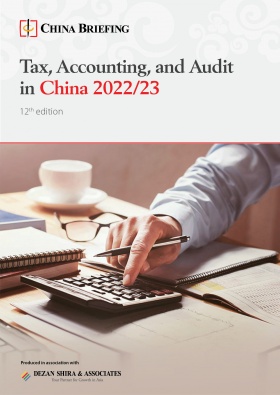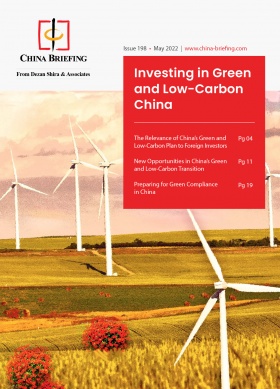China’s Green Building Materials Sector: Policies and Investment Opportunities
China’s green building materials sector presents great opportunities for foreign investment, given the country’s vast real estate market and ambitious plans to meet high environmental standards and serve climate-conscious goals. Foreign investors are advised to keep a close eye on policy developments impacting this sector.
A green building refers to a structure that is energy-saving and environmentally responsible throughout its life cycle. The promotion of green buildings and green building materials is crucial for China’s green and low-carbon plan, given that emissions from buildings’ life cycle accounted for over half of China’s overall emissions in 2019.
This article analyzes the policy trends and opportunities in the green building materials sector in China.
China’s climate goals and the importance of green building materials
In 2020, China made the pledge to peak carbon emissions by 2030 and reach carbon neutrality by 2060. Beyond the mitigation efforts, the Chinese government also released National Climate Change Adaptation Strategy 2035 in May 2022 to better prepare the country to adjust to climate change. In the plan, China aims to build a nationwide climate impact and risk assessment system by 2035, with strengthened early-warning capabilities and environmental impact assessments to improve adaptation mechanisms nationwide.
On the other hand, China is steadily moving towards urbanization, and infrastructure construction is indispensable for its economy. According to market statistics, 5.2 billion square meters of new buildings are built each year, consuming 2 billion tons of cement and 600 million tons of steel annually. Such rapid expansion has driven up emission levels. In 2019, China’s construction sector accounted for 45.8 percent of the total national energy consumption and 50.6 percent of the total national carbon emissions. Given this scenario, it is not hard to understand why construction and construction materials are increasingly being subject to more stringent environmental rules in China.
Against this background, China has made substantial moves to achieve energy saving and energy structure optimization in the construction sector. The green building and green building materials sectors are gradually gaining momentum.
In 2020, China ranked top of the list of Leadership in Energy and Environmental Design (LEED) certification for buildings – for the fifth consecutive year – with more than 1190 newly added LEED registration projects, up 50 percent compared to 2019. Construction of various types of buildings, especially commercial buildings, are encouraged to use low carbon mechanisms and materials to continually reduce emissions and save more energy.
The total value of the green building market in China reached US$178.1 billion in 2021. China plans to expand the green building materials market to about RMB 1.3 trillion (US$180 billion) in 2025 at an annual growth of three percent.
To cater to China’s green and low-carbon plan, more than 90 percent of China’s commercial building owners plan to have at least one net or near-zero energy building in the next 10 years. Globally, China accounts for 17.2 percent of the world’s green building market.
On the financing front, the government and banks promote green financial mechanisms, such as green bonds, green credit, and green funds to develop eco-friendly architecture in China. At the end of 2021, China’s green loan balance was RMB 15.9 trillion (US$2.23 trillion), up 33% year-on-year, and ranked first in the world in terms of stock size. These green credit funds are mainly invested in carbon emission reduction projects.
Categories of green building materials in China
According to the series of documents of the Ministry of Housing and Urban-Rural Development (MHURD), at present, 51 types of products (shown below) are included in the scope of green building materials product certification and graded according to the “Green Building Materials Product Certification Implementation Plan.” Office buildings, hospitals, and public schools are seen as major areas of green building growth.
|
Categories of Green Building Materials
|
||||||
| Envelope structure and concrete | Doors and windows, curtain walls, and decoration category | Waterproof sealing and architectural coatings | Water supply and drainage and water treatment equipment | HVAC and solar energy utilization and lighting | Other equipment class equipment | |
| Prefabricated components | Architectural doors and windows and accessories | Sanitary ware
|
Building sealant | Valves for construction | Air source heat pump | Vibration isolation and noise reduction devices |
| Steel structure housing with steel components | Architectural curtain wall
|
Inorganic decorative panels
|
Waterproof coating | Plastic pipe fittings | Ground source heat pump system | Control and measurement equipment |
| Modern timber frame materials | Building energy-saving glass | Gypsum decorative materials | Wall coatings | Swimming pool circulating water treatment equipment | Fresh air purification system | Mechanical parking equipment |
| Masonry materials | Architectural shading products | Stone material
|
Reflective heat insulation coating | Water purification equipment | Energy storage device for building | |
| Insulation system materials | Profiles for windows, doors, and curtain walls | Magnesium decorative materials
|
Air purification materials | Softening equipment | Photovoltaic module | |
| Ready-mixed concrete | Steel household doors | Ceiling system
|
Resin flooring materials | Oil and grease separators | LED lighting products | |
| Ready-mixed mortar | Metal composite decorative materials | Integrated Wall
|
Building sealant | Water treatment equipment | Light harvesting system | |
| Concrete admixture water-reducing agent | Building ceramics
|
Paper-faced gypsum board
|
Rainwater treatment equipment | Solar photovoltaic system | ||
China’s policies and regulations on developing green building materials
China’s seriousness about promoting green building materials is demonstrated through its policies.
Effective from April 1, 2022, the General Code for Building Energy Conservation and Renewable Energy Utilization (the General Code) issued by the Ministry of Housing and Urban-Rural Development, is the first mandatory document for regulating carbon emissions from buildings and construction. Covering a wind range of subjects, including existing buildings, new buildings, construction commissioning and approval, renewable energy systems, as well as building operations, the General Code called for higher energy-saving standards. More specifically, it requires that all new urban buildings in China be constructed in line with green building standards by 2025 and raises buildings’ utilization of renewable energy from six percent in 2020 to eight percent by 2025.
Soon after that, three departments, including the Ministry of Finance (MOF), jointly released the Circular on Extending the Implementation Scope of Policies on Governments’ Procurement of Green building materials to Improve Building Quality (the Circular) on October 24, 2022. According to the Circular, from November 2022, the Policies on Governments’ Procurement of Green Building Materials to Improve Building Quality will be expanded to 48 cities (municipal districts, including the previous six pilot cities) – targeting hospitals, schools, office buildings, exhibition halls, convention centers, stadiums, housing, and other government procurement projects. The Circular also incorporates the Standards on Governments’ Procurement Demands Concerning Green Building and Green building materials, which is published for strict enforcement by all cities.
On November 7, 2022, the Ministry of Industry and Information Technology (MIIT) released the Action Plan on Peaking Carbon Dioxide Emissions in the Building Materials Industry (Action Plan). The Action Plan sets out 15 key tasks in five aspects to step up total capacity control, improve the level of solid waste utilization, and reduce the use of high-carbon materials. It also stresses efforts in accelerating the research and innovation of low-carbon technologies, promoting energy-saving and carbon-reducing technologies and equipment, and building systems for the production of green building materials and products.
Opportunities for foreign investors
With a large market base and the government’s strong commitment, few would dispute that the green building materials market presents vast potential for foreign investments in the entire supply chain.
According to the latest Encouraged Industries for Foreign Investment (2022 Version), foreign investors are encouraged to invest in multiple sectors related to green building materials, such as:
- Development and production of new technology and products for wood structure and wood building materials, as well as recycling of used wood
- Development and production of energy-saving, environmental protection, waste benefit, light, high strength, high performance, multi-functional building materials
- Organic-inorganic composite foam insulation material production, building high-performance energy-saving insulation materials, modern centralized agricultural production of insulation and isolation materials
- Recycling of construction waste
- Green building land saving and outdoor environment, energy saving, and energy utilization, water saving and water resource utilization, material saving and material resource utilization, indoor environment and operation management comprehensive technology research and utilization
- Advanced system integration technologies and services of low carbon, environmental protection, green, energy saving, and water saving
- Development and application of environmentally friendly technologies.
Looking ahead, the market size for green building materials is set to expand steadily as more buildings opt for eco-friendly materials, either for new construction or upgrades. Foreign investments and expertise will be needed to facilitate such a transition – both in the near term and via sustainability investments over the long term. Strong policies and clear incentives will support opportunities for foreign firms and the transfer of technology.
China Briefing is written and produced by Dezan Shira & Associates. The practice assists foreign investors into China and has done so since 1992 through offices in Beijing, Tianjin, Dalian, Qingdao, Shanghai, Hangzhou, Ningbo, Suzhou, Guangzhou, Dongguan, Zhongshan, Shenzhen, and Hong Kong. Please contact the firm for assistance in China at china@dezshira.com.
Dezan Shira & Associates has offices in Vietnam, Indonesia, Singapore, United States, Germany, Italy, India, and Russia, in addition to our trade research facilities along the Belt & Road Initiative. We also have partner firms assisting foreign investors in The Philippines, Malaysia, Thailand, Bangladesh.
- Previous Article How to Prevent and Deal with Corruption in Your China Business
- Next Article Investing in Hainan: Industry, Economics, and Policy







